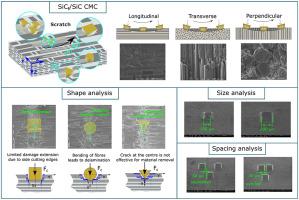International Journal of Machine Tools and Manufacture ( IF 14.0 ) Pub Date : 2020-07-23 , DOI: 10.1016/j.ijmachtools.2020.103580 Gonzalo Garcia Luna , Dragos Axinte , Donka Novovic

|
SiC/SiC Ceramic Matrix Composites (CMCs) have been identified as a key material system for improving aeroengine performance as they offer low density, high strength and stiffness, and superior environmental resistance at high temperatures. Nevertheless, due to their heterogeneous, hard and brittle nature, these materials are considered among the most difficult-to-machine, and grinding arises as one of the preferred choices for their processing. Therefore, understanding of the material removal mechanism and influence of the abrasive grit geometry when grinding CMCs is a critical enabler for achieving high component quality at highest efficiency and minimum cost.
With the aim to reduce the uncertainties associated with the stochastic nature of the abrasive particles, grits of different shapes and sizes have been accurately created by Pulse Laser Ablation (PLA). In order to reproduce the grinding process kinematics, scratch tests in a circular trajectory have been carried out with single abrasive grain with different geometries and sizes, and arrays of overlapped grains to determine the influence of shape, size and spacing on the surface integrity of SiC/SiC CMCs after grinding. The morphology of the various constituents of the workpiece has been assessed regarding the direction of the scratch with respect to the orientation of the fibres. Results reflect a higher influence on the process forces by the grain shape rather than fibre orientation. Moreover, after the inspection of the abraded individual CMC constituents, a change in the mechanisms governing the process for the different abrasive grain geometries have been identified, despite the brittle material removal mode displayed by all of them. Explanation of the ground surface morphology in an analytical and comprehensive manner through a contact mechanics approach shows that the crack onset location is governed by the grains shape but its direction of propagation depends on the fibre orientation.
中文翻译:

砂粒的几何形状和纤维取向对SiC / SiC陶瓷基复合材料(CMCs)磨料去除机理的影响
SiC / SiC陶瓷基复合材料(CMC)被认为是改善航空发动机性能的关键材料系统,因为它们具有低密度,高强度和刚度以及在高温下具有出色的耐环境性。然而,由于它们的异质性,坚硬和脆性,这些材料被认为是最难加工的材料,而研磨则成为其加工的首选之一。因此,在研磨CMC时了解材料去除机理和砂粒几何形状的影响,对于以最高的效率和最低的成本获得高质量的零件至关重要。
为了减少与磨料颗粒的随机性有关的不确定性,已经通过脉冲激光烧蚀(PLA)精确地产生了不同形状和尺寸的砂粒。为了重现磨削过程的运动学特性,已经对具有不同几何形状和尺寸的单个磨料颗粒以及重叠颗粒阵列进行了圆形轨迹的划痕测试,以确定形状,大小和间距对SiC表面完整性的影响。 / SiC CMC研磨后。关于刮痕的方向相对于纤维的取向,已经评估了工件的各种成分的形态。结果反映出晶粒形状而非纤维取向对加工力的影响更大。此外,在检查了磨损的单个CMC成分后,已确定了控制不同磨粒几何形状过程的机制的变化,尽管所有对象均显示了脆性材料去除模式。通过接触力学方法以解析和综合的方式解释了地表形态,结果表明,裂纹的开始位置受晶粒形状控制,但其传播方向取决于纤维的取向。











































 京公网安备 11010802027423号
京公网安备 11010802027423号